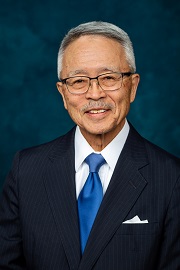
As we look towards the fall we, at R|L we have paused to reflect back over the last several months. What are your learnings and successes from the new normal since the in our COVID pandemic began? R|L Coaches explore this topic with you by providing their own self-discoveries. You won’t want to miss their insights and ponder your own…or better yet, join your family or colleagues on Zoom to engage together and share stories of gratitude and insights on the new path forward.

Clyde Lowstuter, MCC |
Thriving in Uncertainty: from Stuck to Clarity…from Doubt to Certainty
During uncertain times, it is easy to get overwhelmed and stuck in a negative mindset. The reality is that we all struggle with something; the key is to not stay immersed in the stuck place long enough to form a disempowering belief. Here are some tips to help you shift from stuck to clarity…from doubt to certainty.
When you feel stuck or out of control, take a moment to pause, and regroup using one or all of these tips. Best of luck… and keep believing in yourself and others. Together, we are more powerful than we are alone.
|

Carolyn Lowstuter |
Pivot!
In a time of crisis, it is important to focus on where and how you pivot. In basketball players keep one foot anchored in place while allowing their other foot to turn and shift direction in a seamless manner. Using similar agile movements, pivoting in business with similar agile movements works in much the same way. Ground yourself in your core business and purpose. This allows you to be on your toes and ready to pivot. Whether it is changing the immediate focus, a directional shift, a new market, or a new audience, pivoting allows us to take advantage of new opportunities and adapt quickly and wisely. It takes a mindset of curiosity, experimentation, and letting go of preconceived notions. It’s being willing to turn a business model upside down and view it from a different lens so that where the obstacle becomes the opportunity. What is your trusted anchor that will allow you to easily pivot?
|

John Hart |
Leveraging Technology to Bridge the Communications Gap
By now most of us have experienced “Zoom Fatigue” after a couple of hours in a row of being on camera in a row, it can take a lot out of you. With just a little creativity and a couple of clicks at Amazon, it is possible to have a dramatically better experience with online video meetings. I would like to share a couple of simple ideas to transform your experience. 1. Buy a wireless headset – Having the ability to clearly hear a conversation, preferably in both ears, makes a huge difference. The microphone also makes it easy for others to hear your voice clearly. 2. Optimize your lighting – Given that so much of a conversation is nonverbal it is important to have appropriate lighting so that people can unmistakably see your facial expressions. I would recommend using a ring style light, preferably something with warm color temperature. 3. Raise your screen to eye level – This will lower back strain and you will look much more natural. 4. Place the camera at the top of your screen so you are looking more directly at it. 5. If you are using a laptop, try adding an additional, nice large monitor with a camera built-in for less than $200. Your eyes will love the larger image and your back will feel much better as well. Try some of the suggested enhancements for a more professional and lower stress online experience.
|
|
Matt Gonring |
Finding Context for Important Conversations – the How of Successful Delivery
Have you ever heard the old expression, “It’s not what you say, but how you say it”? Well, this old adage is even more pertinent when it comes to important human interactions in the workplace. Others will take your message as you deliver it, but is the conversation consistent with the outcome you desire from the dialogue? How often do we think about the “exchange” strategically manner ahead of time? I counsel my clients regularly on something I refer to as “outcome-based dialogue” or “receiver-centric communications.” Especially as it pertains to important conversations, thinking ahead about the outcome desired from an engagement encourages clients to think about the audience and messaging in a different and more measured way. Writing it down and practicing for important conversations is a way of being more relaxed and self-confident in delivery. It also becomes more apparent as to how others might react to the words when seeing the possible outcomes in print. Adjusting messaging based on your goals for the conversation frequently makes a big difference in the potential outcome or success of the exchange. Then, being aware of non-verbal cues in body language, facial expressions, tones, or even attire and the delivery environment all play into the potential for an exchange. Being aware of your audience enables you to structure the conversation in a manner that more resonates with them. Taking the time to ascertain the “net effect” and being strategic about important conversations measurably increased the potential of a successful outcome from conversations.
|
|
Ron Hirasawa |
Managing Fear During the Pandemic
Few things in life are scarier than facing off with a deadly pandemic enemy you cannot see, hear, or feel coming at you. As the virus mutates to be more infectious every day, our fear grows. What to do? A few ways to combat fear: 1. Become mindful by breathing in deeply through your nose, for a count of 1-7, filling your lungs and abdomen. Hold the breath, counting from 8-11. Slowly exhale through your mouth, counting from 12-19. Something as simple as breathing calms your nervous system and allows you to approach stressful situations in a calm state. 2. Control what you can, beginning with yourself. Decide what behaviors you will practice, such as staying at home, wearing a mask, and washing your hands. What else can you control? 3. Discuss with family and friends what pandemic avoidance behaviors you are practicing and ask them to do the same. Having a plan in place reduces the fear of the unknown. 4. Connect virtually with others. Sociologists confirm that we need frequent human connections to maximize health, good attitude, and longevity. Use free software apps such as Skype, Zoom, and FaceTime to connect with others, share a meal, or enjoy virtual entertainment. When we take an action, whether it is mindful breath, creating a plan, or making a connection, we lower our fears.
|
|
|
If Laughter is the Best Medicine, then Gratitude has to be Running a Close Second
In COVID, it is easy to start down the vicious cycle of worry and stress. Whenever I feel these strong emotions, I often seek laughter to diffuse the negative and help me move forward in a productive way. The last few months, however, have been different. Laughter isn’t enough; what I need — is gratitude. During a shopping trip, the shoppers around me stayed socially distanced. The first person in line tried to wave me in front of him through the checkout. He had three items, and I had fifteen; I thanked him and declined. He completed his purchase, but he didn’t leave the counter. Instead, this stranger stayed and paid for my items. I was speechless and grateful for his kindness. That good feeling stayed with me. I have since paid it forward. The sense of gratitude lingers in a way I wasn’t expecting. Instead of laughter re-centering me, gratitude takes me in a virtuous cycle. Research shows gratitude forces us outside of ourselves and creates a positive connection and related outcome. Go ahead, do some kindness, and feel the gratitude. It is so healing in this difficult time.
|
|
|
Positivity in the Time of COVID
COVID can play with our emotions and sometimes lead us down a negative path. Pause. Seek to find the positive during this time for you to grow personally.
The list is endless. I encourage you to focus on what you can learn, accomplish, and do during this time to focus on the good in life rather than what we have lost. This too shall pass. Be ready when we come out on the other side!
|

Dave Dallam |
The World is a Dangerous Place
The world is a dangerous place. It always was, we just keep finding new dangers in places we used to think were still safe. Just in my children’s lifetimes, we’ve faced many existential threats: HIV/AIDS, Chernobyl, stock market and housing market collapses, 9/11/2001 and expanding global terrorism, killer asteroids, record weather seasons from global climate change, threats to our democracy, and now COVID-19. More, even scarier, will undoubtedly follow. What do I hope to teach my new grandson, born in the midst of this pandemic? Choose to be fearless. Be responsible for the consequences of your actions. Put down your phone. Be a giver and not a taker. Recognize and reward goodness in others. Care for other people, other animals, every living thing. Give your time where you can best be of help. Do what you say you’re going to do. Practice forgiveness and compassion. Practice empathy until it’s your primary virtue. Have the biggest possible positive impact you can on the small circle of people in your life. Be an active participant and not an observer. Make good happen. Call out evil. Love a lot. Will this protect you from contracting COVID-19? From global climate change? From threats to our democracy? Maybe they will if our behaviors have anything to do with how we got here. But even if they don’t protect us, they promise the fullest and richest life any of us can hope for.
|

Kathryn Hartrick |
Leading from a Remote Work Environment
As the pandemic continues and you have not yet returned to the office on a full-time basis, here are some tips for leading meetings in a remote work environment.
This list is only a starting point to create ideas and solutions for making remote work better and more productive. When we take the time to connect and engage with others, we can lead from a more powerful place. Good luck!
|





Great “Words of Wisdom” above from all that blogged. It reminded me of an old saying we used to use at American Hospital Supply (yea I go back that far with R&L) “Tough times don’t last, but tough people do”.
Going though a job change was one of the most emotionally challenging activities I went through as an adult, especially when you have a family depending on you for putting food on the table and a house to live in. R&L helped me through that process three times…..to where I had the confidence to manage the process when change happened and I didn’t have the resources or support of R&L.
I think you call it “member for life”.
Stay safe, stay well.